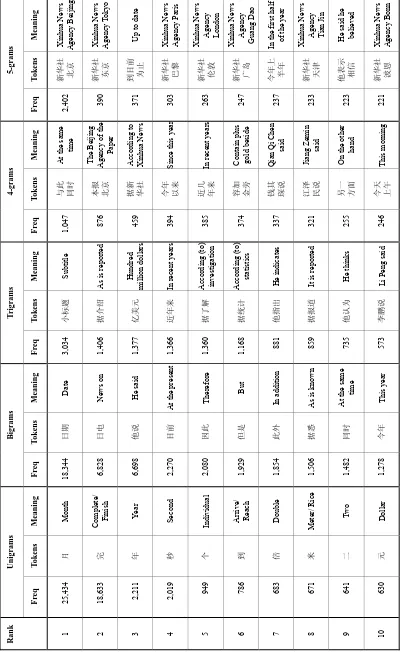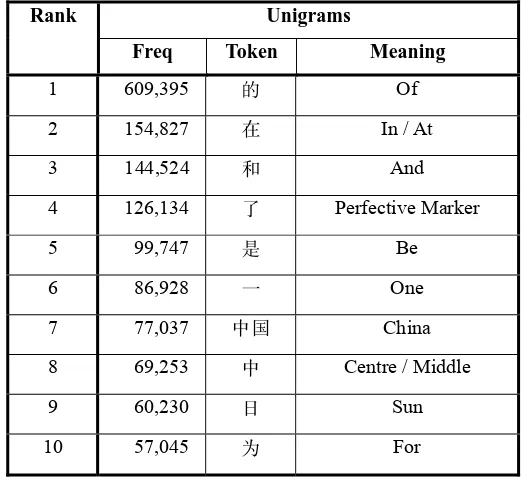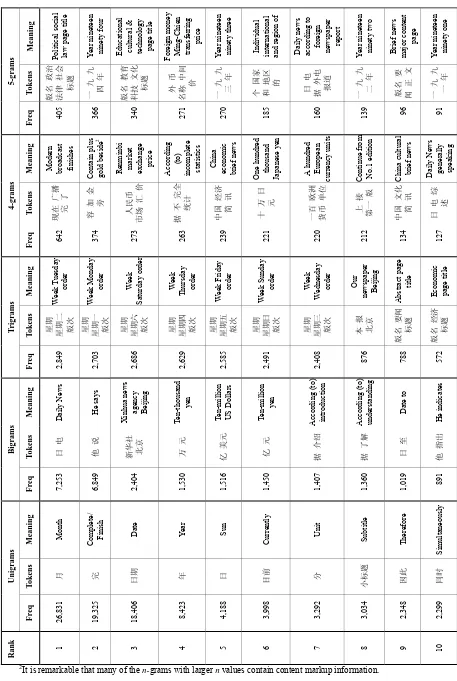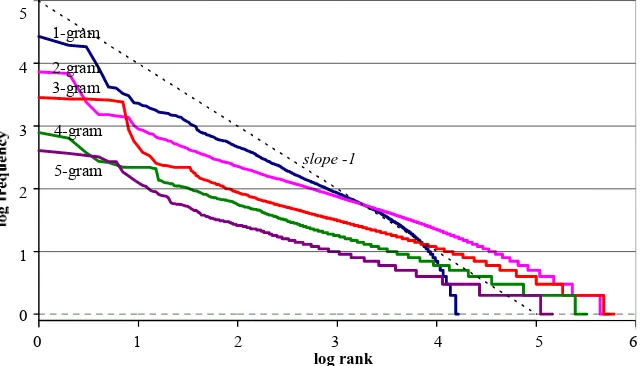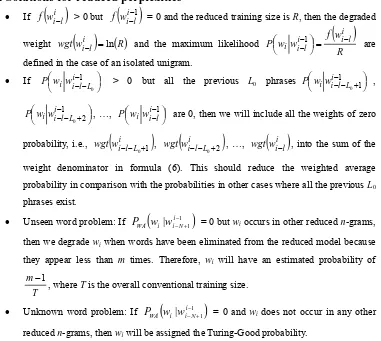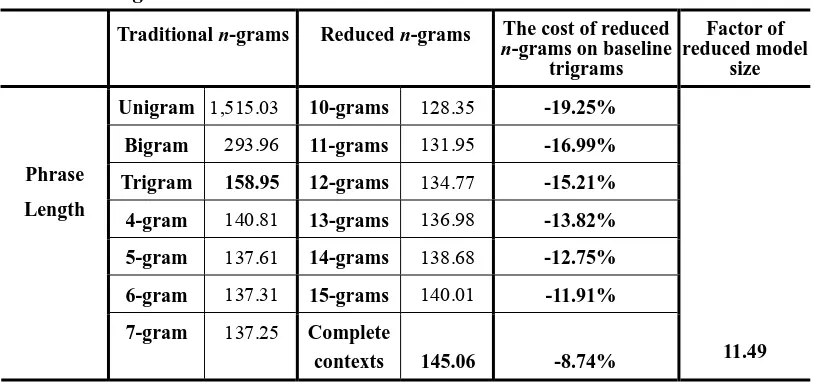Computational Linguistics and Chinese Language Processing
Vol. 10, No. 1, March 2005, pp. 19-34 19
© The Association for Computational Linguistics and Chinese Language Processing
Reduced N-Grams for Chinese Evaluation
Le Quan Ha
*, R. Seymour
+, P. Hanna
*and F. J. Smith
*Abstract
Theoretically, an improvement in a language model occurs as the size of the
n-grams increases from 3 to 5 or higher. As the n-gram size increases, the number
of parameters and calculations, and the storage requirement increase very rapidly if we attempt to store all possible combinations of n-grams. To avoid these problems,
the reduced n-grams’ approach previously developed by O’ Boyle and Smith [1993]
can be applied. A reduced n-gram language model, called a reduced model, can
efficiently store an entire corpus’s phrase-history length within feasible storage limits. Another advantage of reduced n-grams is that they usually are semantically
complete. In our experiments, the reduced n-gram creation method or the O’
Boyle-Smith reduced n-gram algorithm was applied to a large Chinese corpus. The
Chinese reduced n-gram Zipf curves are presented here and compared with
previously obtained conventional Chinese n-grams. The Chinese reduced model
reduced perplexity by 8.74% and the language model size by a factor of 11.49. This paper is the first attempt to model Chinese reduced n-grams, and may provide
important insights for Chinese linguistic research.
Keywords: Reduced n-grams, reduced n-gram algorithm / identification, reduced
model, Chinese reduced n-grams, Chinese reduced model
1.
Introduction to the Reduced N-Gram Approach
P O’ Boyle and F J Smith [1992, 1993] proposed a statistical method to improve language models based on the removal of overlapping phrases.
The distortion of phrase frequencies were first observed in the Vodis Corpus when the bigram “RAIL ENQUIRIES” and its super-phrase “BRITISH RAIL ENQUIRIES” were examined and reported by O’ Boyle. Both occur 73 times, which is a large number for such a small corpus. “ENQUIRIES” follows “RAIL” with a very high probability when it is preceded by “BRITISH.” However, when “RAIL” is preceded by words other than “BRITISH,” “ENQUIRIES” does not occur, but words like “TICKET” or “JOURNEY” may. Thus, the
* Computer Science School, Queen's University Belfast, Belfast BT7 1NN, Northern Ireland, UK.
Email: {q.le, p.hanna, fj.smith}@qub.ac.uk
20 Le Quan Ha et al.
bigram “RAIL ENQUIRIES” gives a misleading probability that “RAIL” is followed by “ENQUIRIES” irrespective of what precedes it. At the time of their research, Smith and O’ Boyle reduced the frequencies of “RAIL ENQUIRIES” by using the frequency of the larger trigram, which gave a probability of zero for “ENQUIRIES” following “RAIL” if it was not preceded by “BRITISH.” This problem happens not only with word-token corpora but also corpora in which all the compounds are tagged as a unit since overlapping n-grams still
appear.
Therefore, a phrase can occur in a corpus as a reduced n-gram in some places and as part
of a larger reduced n-gram in other places. In a reduced model, the occurrence of an n-gram is
not counted when it is a part of a larger reduced n-gram. One algorithm to
detect/identify/extract reduced n-grams from a corpus is the so-called reduced n-gram
algorithm. In 1992, P O’ Boyle and F J Smith were able to store the entire content of the Brown corpus of American English [Francis and Kucera 1964] (of one million word tokens, whose longest phrase-length is 22), which was a considerable improvement at the time. There was no additional way for O’ Boyle to evaluate the reduced n-grams, so his work was
incomplete. We have developed and present here our perplexity method, and we discuss its usefulness for reducing n-gram perplexity.
2.
Similar Approaches and Capability
Recent progress in variable n-gram language modeling has provided an efficient
representation of n-gram models and made the training of higher order n-grams possible.
Compared to variable n-grams, class-based language models are more often used to reduce the
size of a language model, but this typically leads to recognition performance degradation. Classes can alternatively be used to smooth a language model or provide back-off estimates, which have led to small performance gains but also an increase in language model size.
For the LOB corpus, the varigram model obtained 11.3% higher perplexity in comparison with the word-trigram model [Niesler and Woodland 1996], but it also obtained a 22-fold complexity decrease.
22 Le Quan Ha et al.
The pruning algorithm is as follows:
Start with S = T
While (|S| > K)
For all nodes in S calculate d2
Remove node with lowest d2
2.2 The second algorithm [T R Niesler and P C Woodland 1996]
1. Initialisation:L = -1
2. L = L +1
3. Grow: Add level #L to level #(L-1) by adding all the (L+1)-Grams occurring in the training
set for which the L-Grams already exist in the tree.
4. Prune: For every (newly created) leaf in level #L, apply a quality criterion and discard the
leaf if it fails.
5. Termination: If there is a nonzero number of leaves remaining in level #L, goto step 2.
The quality criterion checks for improvement in the leaving-one-out cross-validation training set likelihood achieved by the addition of each leaf.
2.3
Combination of variable n-grams and other language model types
Using the first algorithm, M Siu and M Ostendorf [2000] combined their variable n-gram
method with the skipping distance method and class-based method in a study on the Switchboard corpus, consisting of 2 million words. In 1996, using the second algorithm, T R Niesler and P C Woodland developed the variable n-gram based category in a study on LOB,
consisting of 1 million English words. In order to obtain an overview of variable n-grams, we
combine all of these authors’ results in Table 1.
3.
O’ Boyle and Smith’s Reduced N-Gram Algorithm and Application
Scope
The main goal of this algorithm is to produce three main files from the training text:
• The file that contains all the complete n-grams appearing at least m times is called the
PHR file (m ≥ 2).
• The file that contains all the n-grams appearing as sub-phrases, following the removal
of the first word from any other complete n-gram in the PHR file, is called the SUB
Reduced N-Grams for Chinese Evaluation 23
Table 1. Comparison of combinations of variable n-grams and other Language Models
COMBINATION OF LANGUAGE MODEL TYPES
Basic
n-gram
Variable
n-grams
Category Skipping distance
Classes #params Perpl-
exity
Size Source
Trigram √ 987k 474
Bigram √ - 603.2
Trigram √ - 544.1
√ √ - 534.1
1M LOB
Trigram √ 743k 81.5
Trigram √ 379k 78.1
Trigram √ √ 363k 78.0
Trigram √ √ √ 338k 77.7
4-gram √ 580k 108
4-gram √ √ 577k 108
4-gram √ √ √ 536k 107
5-gram √ 383k 77.5
5-gram √ √ 381k 77.4
5-gram √ √ √ 359k 77.2
2M Switch board Corpus
• The file that contains any overlapping n-grams that occur at least m times in the SUB
file is called the LOS file.
Therefore, the final result is the FIN file of all reduced n-grams, where
FIN := PHR + LOS – SUB. (4)
Before O’ Boyle and Smith‘s work, Craig used a loop algorithm that was equivalent to FIN := PHR – SUB. This yields negative frequencies for resulting n-grams with overlapping,
hence the need for the LOS file. There are 2 additional files:
1. To create the PHR file, a SOR file is needed that contains all the complete n-grams
regardless of m (the SOR file is the PHR file in the special case where m = 1). To
create the PHR file, words are removed from the right-hand side of each SOR phrase in the SOR file until the resultant phrase appears at least m times (if the phrase already
24 Le Quan Ha et al.
2. To create the LOS file, O’ Boyle and Smith applied a POS file: for any SUB phrase, if one word can be added back on the right-hand side (previously removed when the PHR file was created from the SOR file), then one POS phrase will exist as the added phrase. Thus, if any POS phrase appears at least m times, its original SUB phrase will
be an overlapping n-gram in the LOS file.
The application scope of O’ Boyle and Smith ‘s reduced n-gram algorithm is limited to
small corpora, such as the Brown corpus (American English) of 1 million words [1992], in which the longest phrase has 22 words. Now their algorithm, re-checked by us, still works for medium size and large corpora with training sizes of 100 million word tokens.
4.
Reduced N-Grams and Zipf’s Law
By re-applying O’Boyle and Smith’s algorithm, we obtained reduced n-grams from the
Chinese TREC corpus of the Linguistic Data Consortium1, catalog no. LDC2000T52. TREC
was collected from full articles in the People’s Daily Newspaper from 01/1991 to 12/1993 and from Xinhua News Agency articles from 04/1994 to 09/1995. Originally, TREC had 19,546,872 syllable tokens but only 6,300 syllable types. Ha, Sicilia-Garcia, Ming and Smith [2002] proposed an extension of Zipf ’s law and applied it to the TREC syllable corpus. Then in 2003, they produced a compound word version of TREC with 50,000 types, this version was employed in our study for reduced n-gram creation.
We will next present the Zipf curves for Chinese reduced n-grams, starting with
syllables.
4.1
Chinese syllables
The TREC syllable reduced n-grams were created in 28 hours on a Pentium II with 512 MB of
RAM and 2 GB of free hard-drive space.
The most common TREC syllable reduced unigrams, bigrams, trigrams, 4-grams and 5-grams are shown in Table 3. It can be seen that much noise existed in the unigram frequency observations when only one syllable “年 YEAR” re-appeared in the top ten syllable unigrams [Ha, Sicilia-Garcia, Ming and Smith 2002], listed in Table 2.
Reduced N-Grams for Chinese Evaluation 25
Table 2. The 10-highest frequency unigrams in the conventional Chinese TREC syllable corpus [Ha, Sicilia-Garcia, Ming and Smith 2002]
Unigrams Rank
Freq Token Meaning
1 620,619 的 Of
2 308,826 国 State
3 219,543 一 One
4 209,497 中 Centre / Middle
5 176,905 在 In / At
6 159,861 和 And
7 143,359 人 Human
8 139,713 了 Perfective Marker
9 133,696 会 Get Together / Meeting / Association
10 128,805 年 Year
The Zipf [1949] curves are plotted for TREC syllable reduced unigrams and n-grams in
Figure 1. It can be seen that none of the syllable unigram, bigram, trigram, 4-gram and 5-gram curves are straight. The unigram curve has an average slope of –1, while the bigram, trigram, 4-gram and 5-gram curves have slopes of around –0.5. At the beginning, they are very turbulent, crossing each other due to much observed noise at high frequencies.
Figure 1. TREC syllable reduced n-gram Zipf curves
log rank
2 5
1
0 3 4 6
1-gram
2-gram 3-gram
4-gram
5-gram slope -1
0 1 2 3 4
Reduced N-Grams for Chinese Evaluation 27
4.2
Chinese Compound Words
The TREC compound word reduced n-grams obtained using O’ Boyle and Smith ‘s algorithm
were created in 20 hours (we executed the algorithm non-stop for less than one day on a Pentium II with 512 MB of RAM) with a storage requirement of only 1 GB.
The most common TREC word reduced unigrams, bigrams, trigrams, 4-grams and 5-grams are shown in Table 5. One can observe noises in the unigram frequency observations when words with more than 1 syllable appeared in the top ten (“日期 Date,” “目前 Currently,” “小标题 Subtitle,” “因此 Therefore,” and “同时 Simultaneously”), but the 2-syllable word “中国 China” disappeared, as shown in Table 4, which lists the most common traditional TREC word unigrams [Ha et al. 2003].
Our observations of reduced n-grams show that they increase the semantic completeness
of longer n-grams with large n in comparison with conventional Chinese word n-grams [Ha et al. 2003].
Table 4. The 10-highest frequency unigrams in the conventional Chinese TREC word corpus [Ha et al. 2003]
Unigrams Rank
Freq Token Meaning
1 609,395 的 Of
2 154,827 在 In / At
3 144,524 和 And
4 126,134 了 Perfective Marker
5 99,747 是 Be
6 86,928 一 One
7 77,037 中国 China
8 69,253 中 Centre / Middle
9 60,230 日 Sun
Reduced N-Grams for Chinese Evaluation 29
Zipf curves for TREC word reduced unigrams and n-grams are plotted in Figure 2. It can
be observed that the unigram curve not straight, but rather exhibits a two-slope behaviour, beginning with a slope of –0.67 and then falling-off with a slope of approximately -2 at the end. All the bigram, trigram, 4-gram, and 5-gram curves have slopes in the range [-0.6, -0.5] and have become more parallel and straighter. Noise is visible among the TREC word reduced bigrams, trigrams, 4-grams and 5-grams where they turbulently cross each other at the beginning.
Figure 2. TREC word reduced n-gram Zipf curves
Usually, Zipf ‘s rank-frequency law is contradicted by empirical data, and the syllable and compound-word reduced n-grams from Chinese shown in Figure 1 and Figure 2 also
contradict it. In fact, various more sophisticated models for frequency distributions have been proposed by Baayen [2001] and Evert [2004].
5.
Perplexity for Chinese Reduced N-Grams
The reduced n-gram approach was also checked by means of Chinese compound-word
perplexity calculations based on the Weighted Average Model of O’ Boyle and Smith [1993, 1994, 1995, 1997], which was further developed by Sicilia-Garcia, Ming, Smith and Hanna [1999, 2000, 2001]. We rewrote this famous model in formulae (5) and (6):
log rank
2 5
1
0 3 4 6
1-gram
2-gram 3-gram
4-gram
5-gram slope -1
32 Le Quan Ha et al.
models are their ability to store phrase histories that are as long as possible as well as an entire large corpus in a compact database. The test text file had 27,485 words in 3,093 sentences and 927 paragraphs (along with 7 unknown words of 6 types and 109 unseen words of 48 unseen types) for the TREC conventional n-gram model and also for the conventional and reduced
models.
Our Chinese TREC word reduced model was stored in 50 MB of memory, and the perplexity investigation started with phrase-lengths of 10 words and more and increased until all the phrases had been analysed. The perplexity results obtained using the TREC word reduced model are shown in Table 7.
Table 7. Reduced perplexities for Chinese TREC words obtained using the weighted average model
Traditional n-grams Reduced n-grams The cost of reduced
n-grams on baseline
trigrams
Factor of reduced model
size
Unigram 1,515.03 10-grams 128.35 -19.25%
Bigram 293.96 11-grams 131.95 -16.99%
Trigram 158.95 12-grams 134.77 -15.21%
Phrase
Length
4-gram 140.81 13-grams 136.98 -13.82%
5-gram 137.61 14-grams 138.68 -12.75%
6-gram 137.31 15-grams 140.01 -11.91%
7-gram 137.25 Complete
contexts 145.06 -8.74% 11.49
Surprisingly for TREC word reduced n-grams, we achieved an 8.74% perplexity
reduction, and the model size was reduced by a factor of 11.49. Thus, in our study on Chinese TREC words, we achieved improvement in both perplexity and model size.
6.
Conclusions
The conventional n-gram language model is limited in terms of its ability to represent
extended phrase histories because of the exponential growth in the number of parameters. To overcome this limitation, we have re-investigated the approach of O’ Boyle and Smith [1992, 1993] and created a Chinese reduced n-gram model. The main advantage of Chinese reduced n-grams is that they have quite complete semantic meanings thanks to their creation process,
starting from execution of whole sentence contexts.
Reduced N-Grams for Chinese Evaluation 33
syllable unigram Zipf curve has a slope of –1, which satisfies Zipf’s law, and the reduced TREC word unigram Zipf curve shows a two-slope behaviour, similar to the curves reported by Ferrer and Solé [2002]. The difficulties with reduced model perplexity calculations due to statistical, unseen and unknown problems have been solved using the Weighted Average Model, a back-off probability model developed by O’ Boyle and Smith [1993, 1994, 1995, 1997]. By extending TREC word reduced n-grams, we achieved an 8.74% perplexity
reduction, and we were able to reduce the model size by a factor of 11.49. This remarkable improvement in the Chinese TREC reduced n-gram distribution may be smaller that that
possible with the English language, in which the meaning of a word is clearer. This confirms Siu and Ostendorf ‘s [2000] conclusions concerning the potential application of their variable
n-grams to Chinese (and Japanese) and other languages besides English.
Acknowledgements
The authors would like to thank Maria Husin and Dr Sicilia-Garcia for valuable support, the reviewers for their valuable comments and David Ludwig for his revision.
References
Baayen, H., “Word Frequency Distributions,” Kluwer Academic Publishers, 2001.
Evert, S., “A Simple LNRE Model for Random Character Sequences,” Proceedings of the
7èmes Journées Internationales d'Analyse Statistique des Données Textuelles, 2004,
pp. 411-422.
Ferrer I Cancho, R. and R. V. Solé, “Two Regimes in the Frequency of Words and the Origin of Complex Lexicons,” Journal of Quantitative Linguistics, 8(3) 2002, pp. 165-173.
Francis, W. N. and H. Kucera, “Manual of Information to Accompany A Standard Corpus of Present-Day Edited American English, for use with Digital Computers,” Department of Linguistics, Brown University, Providence, Rhode Island, 1964.
Ha, L. Q., E. I. Sicilia-Garcia, J. Ming and F. J. Smith, “Extension of Zipf ’s Law to Word and Character N-Grams for English and Chinese,” Journal of Computational
Linguistics and Chinese Language Processing, 8(1) 2003, pp. 77-102.
Ha, L. Q., E. I. Sicilia-Garcia, J. Ming and F. J. Smith, “Extension of Zipf ’s Law to Words and Phrases,“ Proceedings of the 19th International Conference on Computational
Linguistics, vol. 1, 2002, pp. 315-320.
Hu, J., W. Turin and M. K. Brown, “Language Modeling using Stochastic Automata with Variable Length Contexts,” Computer Speech and Language, vol. 11, 1997, pp. 1-16.
Kneser, R., “Statistical Language Modeling Using a Variable Context Length,” ICSLP, vol.
1, 1996, pp. 494-497.
34 Le Quan Ha et al.
Niesler, T. R. and P. C. Woodland, “A Variable-Length Category-Based N-Gram Language
Model,” IEEE ICASSP, vol. 1, 1996, pp. 164-167.
O' Boyle, P., J. McMahon and F. J. Smith, "Combining a Multi-Level Class Hierarchy with Weighted-Average Function-Based Smoothing,” IEEE Automatic Speech Recognition
Workshop, Snowbird, Utah, 1995.
O' Boyle, P. and M. Owens, "A Comparison of human performance with corpus-based language model performance on a task with limited context information,” CSNLP,
Dublin City University, 1994.
O' Boyle, P., M. Owens and F. J. Smith, "A weighted average N-Gram model of natural
language,” Computer Speech and Language, vol. 8, 1994, pp. 337-349.
O’ Boyle, P. L., J. Ming, M. Owens and F. J. Smith, "Adaptive Parameter Training in an Interpolated N-Gram language model,” QUALICO, Helsinki, Finland, 1997.
O’ Boyle, P. L., “A study of an N-Gram Language Model for Speech Recognition,” PhD
thesis, Queen’s University Belfast, 1993.
Sicilia-Garcia, E. I., “A Study in Dynamic Language Modelling,” PhD thesis, Queen’s University Belfast, 2001.
Sicilia-Garcia, E. I., J. Ming and F. J. Smith, “A Dynamic Language Model based on Individual Word Domains,” Proceedings of the 18th International Conference on
Computational Linguistics COLING 2000, Saarbrucken, Germany, vol. 2, 2000, pp.
789-794.
Sicilia-Garcia, E. I., J. Ming and F. J. Smith, “Triggering Individual Word Domains in
N-Gram Language Model,” Proceedings of the European Conference on Speech
Communication and Technology (EuropeSpeech), vol. 1, 2001, pp. 701-704.
Sicilia-Garcia, E. I., F. J. Smith and P. Hanna, “A Dynamic Language Model based on Individual Word Models,” Pre-proceedings of the 10th Irish Conference on Artificial
Intelligence and Cognitive Science AICS 99, Cork Ireland, 1999, pp. 222-229.
Siu, M. and M. Ostendorf, “Integrating a Context-Dependent Phrase Grammar in the Variable N-Gram framework,” IEEE ICASSP, vol. 3, 2000, pp. 1643-1646.
Siu, M. and M. Ostendorf, “Variable N-Grams and Extensions for Conversational Speech
Language Modelling,” IEEE Transactions on Speech and Audio Processing, 8(1) 2000,
pp. 63-75.
Smith, F. J. and P. O’ Boyle, “The N-Gram Language Model,” The Cognitive Science of
Natural Language Processing Workshop, Dublin City University, 1992, pp. 51-58.
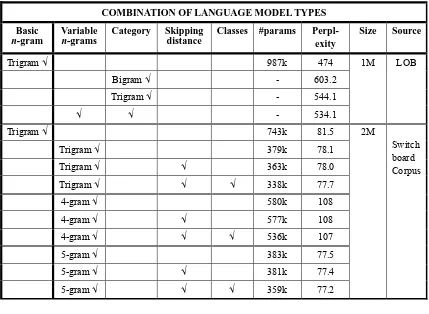
![Table 2. The 10-highest frequency unigrams in the conventional Chinese TREC syllable corpus [Ha, Sicilia-Garcia, Ming and Smith 2002]](https://thumb-us.123doks.com/thumbv2/123dok_us/1095266.1138413/7.595.134.438.156.380/highest-frequency-unigrams-conventional-chinese-syllable-sicilia-garcia.webp)
